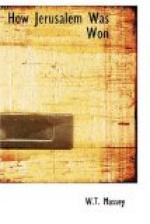General Allenby, looking well ahead and realising the possibilities opened out by his complete success in every phase of the operations on the Turks’ main defensive line, on the 10th November ordered the 52nd and 75th Divisions to concentrate on their advanced guards so as to support the cavalry on their front and to prevent the Turk consolidating on the line of the wadi Sukereir. The enemy was developing a more organised resistance on a crescent-shaped line from Et Tineh through Yasur to Beshshit, and it was necessary to adopt deliberate methods of attack to move him. The advance on the 11th was the preliminary to three days of stirring fighting. The Turks put up a very strong defence by their rearguards, and when one says that at this time they were fighting with courage and magnificent determination one is not only paying a just tribute to the enemy but doing justice to the gallantry and skill of the troops who defeated him. The Scots can claim a large share of the success of the next two days, but British yeomanry took a great part in it, and their charge at Mughar, and perhaps their charge at Abu Shushe as well, will find a place in military text-books, for it has confounded those critics who declared that the development of the machine gun in modern warfare has brought the uses of cavalry down to very narrow limits.
The 156th Brigade was directed to take Burkah on the 12th so as to give the infantry liberty of manoeuvre on the following day. Burkah was a nasty place to tackle. The enemy had two lines of beautifully sited trenches prepared before he fell back from Gaza. The Scots had to attack up a slope to the first line, and having taken this to pass down another slope for 1000 yards before reaching the glacis in front of the second line. The Scottish Rifles assaulted this position by day without much artillery support, but they took it in magnificent style. It looked as if the Turks had accepted the verdict, but at night they returned to a brown hill on the right and drove the 4th Royal Scots from it. This battalion came back soon afterwards and retook the hill with the assistance of some Gurkhas of General Colston’s 233rd Infantry Brigade, and the Turk retired to another spot, hoping that his luck would change. While




